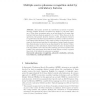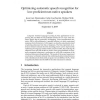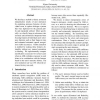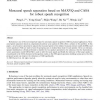ACL
2012
12 years 5 months ago
2012
Previous approaches to instruction interpretation have required either extensive domain adaptation or manually annotated corpora. This paper presents a novel approach to instructi...
IEAAIE
2011
Springer
13 years 6 months ago
2011
Springer
This paper presents an experiment in speech recognition whereby multiple phoneme recognisers are applied to the same utterance. When these recognisers agree on an hypothesis for th...
INTERSPEECH
2010
13 years 10 months ago
2010
Using GMM-supervectors as the input to SVM classifiers (namely, GMM-SVM) is one of the promising approaches to text-independent speaker verification. However, one unaddressed issu...
EJASMP
2010
13 years 10 months ago
2010
Computer Assisted Language Learning (CALL) applications for improving the oral skills of low-proficient learners have to cope with nonnative speech that is particularly challengin...
COLING
2010
13 years 10 months ago
2010
Unrehearsed spoken language often contains disfluencies. In order to correctly interpret a spoken utterance, any such disfluencies must be identified and removed or otherwise deal...
SIGDIAL
2010
14 years 1 months ago
2010
We develop a method to detect erroneous interpretation results of user utterances by exploiting utterance histories of individual users in spoken dialogue systems that were deploy...
TASLP
2008
14 years 3 months ago
2008
Abstract-- This paper presents a fully automatic news skimming system which takes a broadcast news audio stream and provides the user with the segmented, structured and highlighted...
CSL
2010
Springer
14 years 3 months ago
2010
Springer
Robustness is one of the most important topics for automatic speech recognition (ASR) in practical applications. Monaural speech separation based on computational auditory scene a...
COGSCI
2010
14 years 3 months ago
2010
With human language, the same utterance can have different meanings in different contexts. Nevertheless, listeners almost invariably converge upon the correct intended meaning. Th...
COLING
1996
14 years 4 months ago
1996
This paper presents a unified theory of verbal irony tbr developing a computational model of irony. The theory claims that an ironic utterance implicitly communicates the fact tha...





